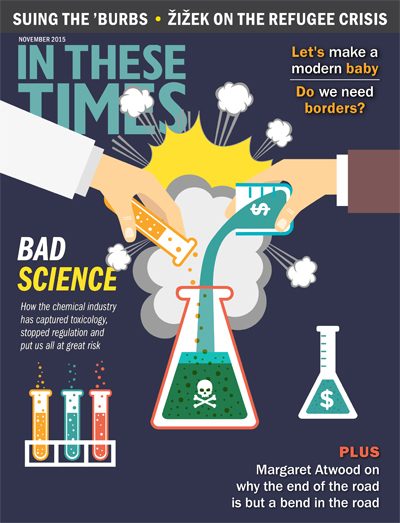A Chemical-Industrial Complex
Why do many hazardous chemicals go unregulated in the United States? An In These Times investigation reveals the answer.
Joel Bleifuss

Many of you reading this have lost a family member or a friend to cancer. The American Cancer Society reports that cancer will kill nearly 590,000 Americans this year. Many more people will suffer from metabolic, reproductive or neurological disorders. Some of these problems and diseases can be attributed to lifestyle factors or to genetic predispositions. But much of this disease burden can be blamed on chemicals that pollute our everyday environment.
This is particularly true of “endocrine disruptors,” chemicals that mimic our hormones and can wreak havoc with our bodies’ health. Exposure to such chemicals is thought to be responsible for increases, over the past several decades, in diabetes, obesity, infertility, behavior disorders and various cancers: testicular, prostate, thyroid, breast and non-Hodgkin’s lymphoma. For example, according to the National Cancer Institute, between 2003 and 2012, the number of cases of thyroid cancer increased by nearly 80 percent and the number of deaths by nearly 30 percent.
The conundrum is: Why, based on what we know, do so many chemicals, including endocrine disruptors, remain unregulated?
In the November issue of In These Times, investigative journalists Valerie Brown and Elizabeth Grossman report the heretofore missing piece of that puzzle: In the 1980s, a group of Defense Department-funded researchers promoted a new computer-based method to calculate the risk that toxic chemicals pose to human health. Unlike laboratory experiments based on concrete observations, computational models are only as good as the parameters the scientists set. This makes it easy for researchers to achieve desired results.
In 1988, these scientists wrote about the “far-reaching” benefits of this new method of chemical risk assessment: It could prevent federal regulators, like those in the EPA, from setting “excessively conservative” exposure limits that would lead to “unnecessary expensive controls.”
The other factor in play is that Big Chem invests heavily in Congress, which sets the budgets of federal agencies like the EPA. For example, Dow Chemical, a leading producer of bisphenol A (BPA), an endocrine disruptor common in plastics, spent more than $1 million in the 2013-14 election cycle, most of that lucre going to Republicans. Monsanto, which invented glyphosate — a carcinogen, a suspected endocrine disruptor and the most widely used herbicide in the world — contributed more than $530,000 during the same cycle, also mostly to Republicans. It’s no accident that both of these hazardous chemicals are stuck in regulatory purgatory.
Members of Congress are not the only ones beholden to those who profit from toxic chemicals. Many scientists have moved back and forth between federal agencies and the more lucrative private sector. There, they do stints at for-profit consultancies with ties to industry players like Dow and the American Chemistry Council.
As Brown and Grossman report, these scientists are an integral part of a chemical-industrial complex that champions a scientific method that has protected chemical corporations from regulation — and from liability for the untold thousands of deaths that their poisons cause.
Joel Bleifuss, a former director of the Peace Studies Program at the University of Missouri-Columbia, is the editor & publisher of In These Times, where he has worked since October 1986.









